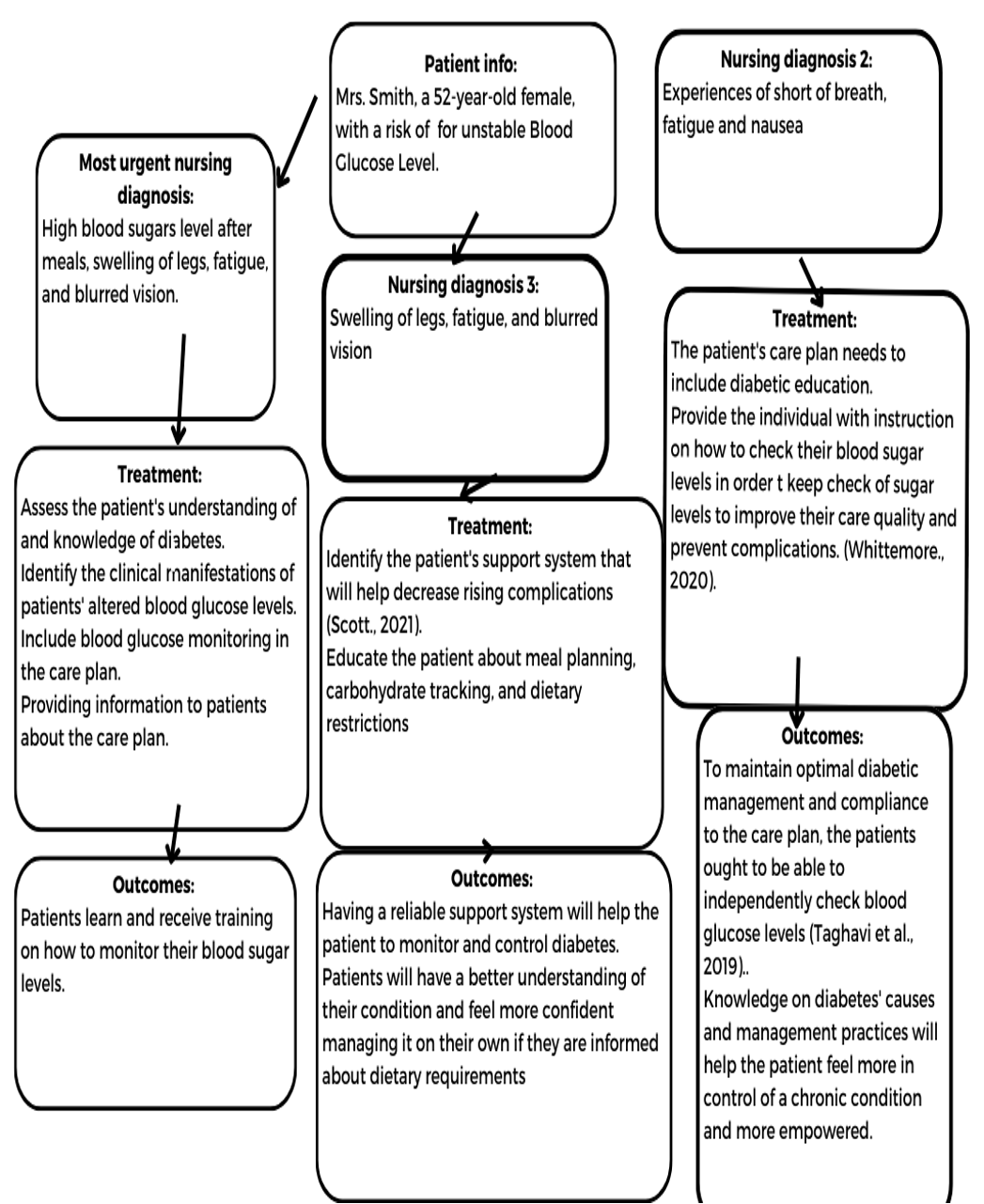Diabetic individuals and their loved ones face biopsychosocial difficulties due to diabetes mellitus. Activities aimed at achieving metabolic control and preventing future diabetic complications are significantly impacted by psychological and social challenges that affect people with Type 2 diabetes. This paper evaluates a plan to achieve high-quality outcomes for a patient. The concept map contains information on the patient, different nursing diagnoses, appropriate treatments, and intended outcomes. The narrative validates the evidence used in the concept map and provides additional evidence to support the recommended nursing care treatments.
Concept Map 1

Value and Relevance of Evidence
A nursing diagnosis is a formative assessment concerning a person, family, or community’s experiences with current or anticipated health problems and life experiences that may be associated with nursing practice. As an ICU nurse in the practices, there is a patient Mrs. Smith, a 52-year-old female with a history of Type II Diabetes Mellitus who is hospitalized with elevated glucose levels and Acute Renal Failure. In the diagnosis, she shows other complications, including swelling legs, blurred vision, and exhaustion.
Nursing diagnoses promote independence, for example, Mrs. Smith needs comfort since she is also managing the disease independently and making her meals because her daughter, who can help, has kids and works that Mrs. Smith does not entirely depend on her. Also, Mrs. Smith gets treatments based on medical directives, for instance, medication administration. Her nursing diagnoses are created using data gathered during the nursing evaluation, like her details on having blurred visions and swollen legs.
The goal of evidence-based diabetes care is to assemble data from applied clinical research on the assessment, diagnosis, and treatment of a broad range of diabetes-related health conditions. Various sources helped to create value and reliable information in the concept map of Mrs. Smith’s health diagnosis, treatments, and desired outcomes. The resources provided information on improving the patient’s health by lowering blood glucose levels to enhance the quality of life. Also, evidence-based resources with information on diabetes patients’ instructions are required to assist the patient in disease management. The reliance on evidence-based resources is that diabetic patients need knowledge of the disease and management to maintain blood glucose levels and prevent long-term complications.
Interprofessional Strategies
In nursing education, concept maps have been demonstrated to encourage clinical thinking and critical reasoning. By illustrating how theoretical information may be immediately applied to primary care with patients and their families, they have also been linked to programs and interventions in connecting theory and practice. To help attain the intended results, interprofessional tactics can be implemented in the concept map. Interprofessional teams might work together to deliver patient guidance and self-management that can enhance patient outcomes.
There is conscious linking and distinguishing concepts, and knowledge domains, in a hierarchical system while creating concept maps. Thus, the outcome is combined knowledge from prior experience and recently learned the information on patient guidance and self-management that can enhance patient outcomes. Furthermore, to give patients the best care possible, practitioners must gather and combine various data with their prior knowledge.
Collaboration and team-based care are crucial components of contemporary health care and knowledge integration. The most efficient way to utilize the skill sets of healthcare professionals is through physician-led team-based care. Also, the value and necessity of teamwork in a healthcare setting and the significance of information integration for clinical reasoning are vital in patient guidance and self-management, which can enhance patient outcomes.
Conclusion
Diabetes type 2 Mellitus is a medical disorder associated with various complications. Recognizing and addressing specific difficulties can aid in developing type 2 diabetes treatment by reducing symptoms. By summarizing related information, concept mapping aids in the organization of comorbidity information. As a result, a concept map is a valuable tool for finding the most effective nursing actions to obtain the most significant potential care outcomes.
References
Scott, M. (2021). Critical care nursing: Diagnosis and management, 3rd EDN. Intensive and Critical Care Nursing, 16(5), 330. https://doi.org/10.1054/iccn.2000.1497
Taghavi Larijani, T., & Saatchi, B. (2019). Training of nanda‐i nursing diagnoses (NDS), Nursing Interventions Classification (NIC) and Nursing Outcomes Classification (NOC), in psychiatric wards: A randomized controlled trial. Nursing Open, 6(2), 612–619. https://doi.org/10.1002/nop2.244
Whittemore, R. (2020). A multicomponent intervention improved diabetes care in primary care practices. Evidence-Based Nursing, 12(3), 89–89. https://doi.org/10.1136/ebn.12.3.89
 write
write